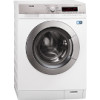AEG L87405FL Product Manual - Page 19
Hints And Tips - manual
 |
View all AEG L87405FL manuals
Add to My Manuals
Save this manual to your list of manuals |
Page 19 highlights
11. HINTS AND TIPS WARNING! Refer to Safety chapters. 11.1 The laundry load • Divide the laundry in: white, coloured, synthetics, delicates and wool. • Obey the washing instructions that are on the laundry care labels. • Do not wash together white and coloured items. • Some coloured items can discolour with the first wash. We recommend that you wash them separately for the first times. • Button up pillowcases, close zippers, hooks and poppers. Tie up belts. • Empty the pockets and unfold the items. • Turn inside out multilayered fabrics, wool and items with painted illustrations. • Remove hard stains. • Wash with a special detergent heavy soil stains. • Be careful with the curtains. Remove the hooks or put the curtains in a washing bag or pillowcase. • Do not wash in the appliance laundry without hems or with cuts. Use a washing bag to wash small and/or delicate items (e.g. underwired bras, belts, tights, etc. ). • A very small load can cause balance problems with the spin phase. If this occurs, adjust manually the items in the tub and start the spin phase again. 11.2 Stubborn stains For some stains, water and detergent is not sufficient. We recommend that you remove these stains before you put the items in the appliance. Special stain removers are available. Use the special stain remover that is applicable to the type of stain and fabric. ENGLISH 19 11.3 Detergents and additives • Only use detergents and additives specially made for washing machines: - powder detergents for all types of fabric, - powder detergents for delicate fabrics (40 °C max) and woollens, - liquid detergents, preferably for low temperature wash programmes (60 °C max) for all types of fabric, or special for woollens only. • Do not mix different types of detergents. • To help the environment, do not use more than the correct quantity of detergent. • Obey the instructions that you find on the on packaging of these products. • Use the correct products for the type and colour of the fabric, the programme temperature and the level of soil. • If your appliance has not the detergent dispenser with the flap device, add the liquid detergents with a dosing ball (supplied by the detergent's manufacturer). 11.4 Ecological hints • Set a programme without the prewash phase to wash laundry with normal soil. • Always start a washing programme with the maximum load of laundry. • If necessary, use a stain remover when you set a programme with a low temperature. • To use the correct quantity of the detergent, check the water hardness of your domestic system 11.5 Water hardness If the water hardness in your area is high or moderate, we recommend that you use a water softener for washing machines. In areas where the water hardness is soft it is not necessary to use a water softener. To know the water hardness in your area, contact your local water authority.















